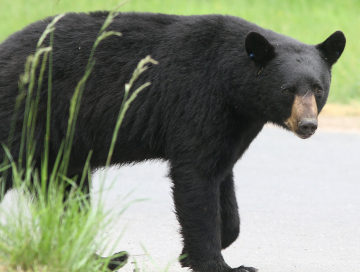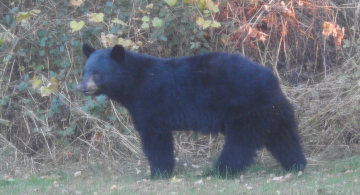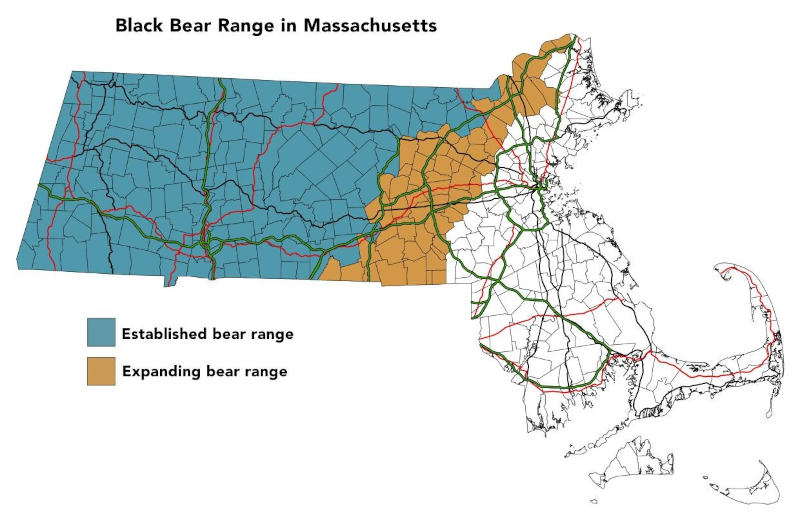Nature Notes

PHOTO COURTESY OF GARRY KESSLER
Black bears are native to North America and the only bear species in Massachusetts.
September 19, 2024
NATURE NOTES
By Annie Reid
Westborough Community Land Trust
Get ready for black bears
Bears in town? Maybe, or at least, more likely than ever. It seems time for people in Westborough and nearby towns to get ready to live with bears. Folks in towns farther west in Massachusetts have done so over the past 15-50 years.
We’ve long heard tales of people finding signs of bear in local woods, namely possible bear scat – the legendary bear poop in the woods. Decades ago, a Westborough newspaper ran a story one spring, complete with photo, about a bear marauding birdfeeders while passing through town.
And now? At least one bear sighting has been reported to the Town animal control officer for three years (2024, 2023, 2022). In May of this year, animal control officer Melinda MacKendrick noted the possibility of three bears in town (Community Advocate https://www.communityadvocate.com/2024/05/03/black-bears-sighted-in-and-around-westborough). That’s at least one bear, possibly two or even three. They could be residents or just passing through.
So what about these bears, or this bear? The bear in question is a black bear (Ursus americanus), native to North America and the only bear species in Massachusetts. (Don’t worry, it’s NOT a grizzly bear (Ursus arctos horribilis), a more aggressive bear not found in Massachusetts or anywhere close). Black bears lived in Massachusetts when European colonists arrived in 1620. The bear population dwindled to 12 or fewer by the 1880s as people cleared away forests – bear habitat – for farming and killed off bears. Even in 1940 the count was just 10. Now that forests have returned to Massachusetts and hunting is closely regulated, black bears have made a come-back in western Mass and are spreading eastward. The state’s bear population is 4,500-5,000.
How do you feel about the idea of a black bear in our local woods? The notion can provoke strong first reactions. Some people might react with fear and even panic. Others might feel curious and tempted to attract a bear for a closer look. Either way, knowing more about black bears can help people to moderate these reactions.
When might you see a bear? As with so many wild animals, the most likely time of day is around dawn or dusk. As for time of year, spring is when black bears come out of hibernation (March-April). Spring is also when young bears wander the countryside to find territories of their own.

PHOTO COURTESY OF Barbara Volkle
A black bear visiting a backyard in nearby Northborough.
Now, in autumn, black bears start feasting to put on enough fat to carry them through their winter hibernation, which starts November-December. They eat constantly to increase their weight by 50-100 percent. As one naturalist and wildlife rehabilitator in Vermont put it, every day in fall bears need to eat the same number of calories as found in 15-20 pints of Ben & Jerry’s ice cream.
Also, after breeding in late June-early July, female black bears need to gain weight (about 50 percent) before their pregnancy can get under way. That’s due to a process called delayed implantation, in which fertilized eggs go dormant and don’t implant in the uterus to start developing until triggered by an appropriate weight gain. (Many other animals – including rodents, weasels, otters, and opossums – also have forms of delayed implantation.)
Would you be surprised to learn that black bears’ diet consists of 85 percent plant matter? They also eat some meat – typically deer fawns, grubs, bees, bee larvae, ants, wasps, fish, carrion (dead animal remains). We may think of them as carnivores, but they’re actually omnivores (eating everything). They are, however, capable of taking a fox or coyote, as well as mice and other small mammals.
In spring, black bears eat buds, grasses and new greenery, sedges, even skunk cabbage, and deer fawns. In summer, they seek out wild berries (cherries, raspberries, blackberries, blueberries), bees, insect larvae, apples, and carrion. In fall, they fatten on acorns, beechnuts, and hickory nuts. In this season, competitors for nuts include deer, squirrels, chipmunks, porcupines, raccoons, and even bluejays and wild turkeys.
In winter, black bears usually hibernate, so they disappear from the landscape (Dec-Mar). They make dens in brush piles, under fallen tree trunks, in holes under tree roots, or in large hollow trees. We might think of hibernation as a way of escaping the cold, but it’s really a way of getting through a period of little or no available food. Bears’ body processes slow. For example, their heart rate drops to 8-12 beats a minute (from 40-50 beats), and they breathe only once or twice a minute (every 45 seconds).
Yet their “sleep” is relatively light. Their body temperature drops only about 12 degrees, to 88 degrees F, and goes through cycles of rising and falling. They change position every couple of days. They can rouse themselves relatively quickly. Females awaken to give birth to 2-3 cubs in January and lick and nurse them. The family emerges from the den in March. The cubs stay with the mother through another winter, for a total of 16-17 months.
Black bears are not naturally aggressive. They tend to avoid people. Black bears are not especially territorial, and their ranges often overlap. They’ve been described as having a “polite, adaptable nature.”
Yet black bears are wild animals, and it’s critical to keep them that way. The key is not to let bears learn to associate people with food. In other words, do NOT feed them, either deliberately or inadvertently. We don’t want them to lose their natural fear of humans and to become habituated to people. If bears become “nuisance animals,” defined as predators that wander too close to human populations for human comfort, it can be dangerous for people, their property, and the bears.
How might someone unintentionally attract a bear? More ways than you might think. Bears will eat birdseed, so do NOT fill birdfeeders with seed or suet after mid-March. Bears will also eat garbage, meat in compost piles, pet food left outside, corn in corn fields, fruit in orchards. Beehives and chicken coops tempt them but can be protected by electric fences.
See these Massachusetts resources:
Living with Black Bears Fact Sheet https://www.mass.gov/doc/living-with-black-bears-fact-sheet/download
Coexisting with Black Bears in Massachusetts https://www.mass.gov/media/9726/download
Printable Quick Tips for Avoiding Bear Conflicts https://www.mass.gov/doc/printable-quick-tips-for-avoiding-bear-conflicts/download
We can look forward to sharing our local natural environment with bears, but let’s leave them alone and give them plenty of space.

This map of the black bear range in Massachusetts shows a brown area where the bear range is expanding. That area includes Westborough and nearby towns.
Date index
Month (September)
Common name index
Scientific name index
Category index